The British and the Battle of the Ardennes
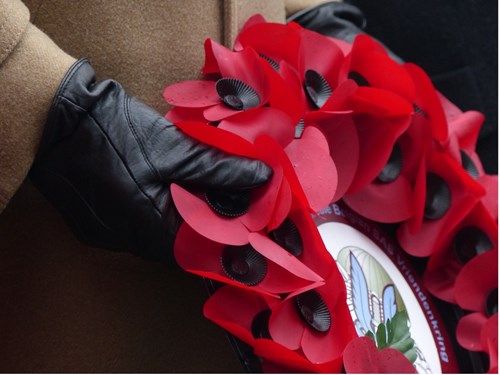
© WBT F. Puls
The British contribution in the Battle of the Ardennes, limited in numbers, pressed for time but stamped with the authority of its Commander-in-Chief, Field Marshal Bernard Montgomery, cannot be underestimated. Guy Blockmans, a former member of the branch, produced an authoritative guide to the battlefield sites some years ago for the Belgian Wallonia Tourist Office. We are grateful to Philippe Marée of the Belgian Wallonia Tourist Office in London for allowing us to re-produce excerpts from the guide’s chapter on The British in the Battle and offering superb photographs to illustrate the text.
On 20 December 1944, Montgomery ordered XXX Corps, under the command of Lieutenant-General Brian Horrocks, to leave the Netherlands and move towards the combat zone of the Ardennes.
By 22 December, the 51st (Highland) Division, the 53rd (Welsh) Division and the Guards’ Armoured Division took up defensive positions between Maastricht and Givet to try to prevent German troops from crossing the River Meuse. The 6th Airborne Division, who were back in Britain following their exploits in Normandy, received the order to move to the Ardennes.
On 3 January 1945, in the cold and snow of the Tellin-Rochefort-Hotton triangle, XXX Corps launched its counter-offensive. The 6th Airborne Division, the 53rd (Welsh) Division and the 51st (Highland) Division, with their supporting armoured units, moved towards the front. The 43rd (Wessex) Division was held in reserve.
On 16 January, with the battle almost won, Montgomery withdrew XXX Corps units from the Ardennes and sent them back to the Netherlands to prepare for the long-planned offensive into Germany and the crossing of the Rhine.
Florennes
On 25 December 1944, the 1st Northamptonshire Yeomanry armoured regiment arrived in Florennes, and were quartered in its aerodrome buildings before moving to the combat zone to support units engaged in the counter-offensive. Built in 1942 by the Luftwaffe and liberated in September 1944 by American troops, the aerodrome would be used by the Fighter and Bomber Groups of the US Airforce.
Spitfire Memorial Museum
Located in the aerodrome buildings, the Museum displays a 1944 MK XIV Spitfire as well as Belgian aircraft. The Museum also covers the history of the aerodrome and of the squadrons that were based there, with many display cases containing photographs, documents, flight-equipment, model aircraft and souvenirs. Visits must be booked in advance. Check the website for opening hours. www.spitfiremuseum.be
Dinant
During the evening of 23 December, at the foot of the ‘Bayard Rock’, a jeep-load of Germans wearing American uniforms drove through a checkpoint and detonated a daisy-chain of mines laid by British soldiers guarding access to the town and the bridge across the Meuse.
Celles

Panther tank of 2.Panzer which struck a mine at Celles crossroads © WBT P. Marée
On 24 December at the Celles crossroads, the lead tank of an armoured column of 2. Panzer struck a mine and was immobilized. Believing that all roads towards Dinant were mined, the commander of the column decided to move his tanks across country, but lack of fuel and ammunition curtailed the advance. The column was spotted and trapped in a pincer movement by the 3rd Royal Tank Regiment and a unit of the US 2nd Armored Division, with Allied fighter bombers in support.
The day after Christmas, the German armoured column was annihilated and the ‘German Pocket’ of Celles and Foy-Notre-Dame captured. The planned breakthrough of the 5th Panzer Army was thwarted. The Germans would not cross the River Meuse and would never reach Antwerp and its crucial port facilities.
Rochefort
On 23 December 1944, the vanguard of Panzer Lehr clashed with the 335th Infantry Regiment of the 84th US Infantry Division. The besieged Americans received the order to withdraw and succeeded in breaking through the encircling forces.
On 3 January 1945, paratroopers from the 1st Canadian Parachute Battalion entered the town, cleaning out pockets of German resistance. They also carried out reconnaissance patrols around Rochefort, positioned an artillery battery atop the feudal castle, and then continued their advance towards Marche-en-Famenne.
Bure
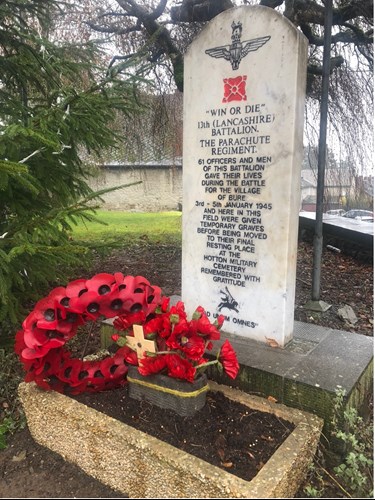
Headstone commemorating 61 men of the 13th (Lancashire) Battalion Parachute Regiment killed in the Battle of Bure (Major Jack Watson MC Square) © WBT P. Marée
At dawn on 3 January 1945, in the cold and snow, the 13th (Lancashire) Battalion Parachute Regiment left Resteigne on foot and headed towards the enemy occupied village of Bure. At 13:00, from the edge of the forest, the British launched their attack. As soon as the paras left the cover of the trees they came under heavy machine-gun and mortar fire as well as shelling from a Panther tank. Undaunted, they pressed on, moving from house to house. After three days of heavy fighting, sometimes hand-to-hand, and suffering heavy losses, the British gained control of the village.
The same evening, the paras had orders to continue their advance. They also liberated Wavreille, Grupont, Jemelle, On, Hargimont, Nassogne, Amberloup, Ambly, Marloie, Waha and Roy.
A memorial to three Belgian SAS men killed on a reconnaissance patrol, while supporting the paras, stands on high ground south-west of Bure, via Rue de Miwart and Rue des Roches.

Plaque to Major Jack Watson MC, who commanded the paras at Bure © WBT F. Puls
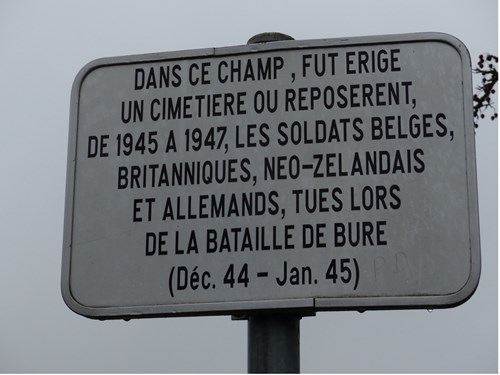
© WBT F. Puls
Saint Hubert
From 26 December 1944, a squadron of French SAS paratroopers attached to 6th Airborne Division was in action east of the town, protecting the flanks of the British paras and establishing links with the 87th US Infantry Division with reconnaissance patrols.
On 11 January 1945, ahead of the men of the 87th, French SAS entered the town, chasing out the last Germans and capturing 20 prisoners. The paras hoisted the French flag above the town hall and the local authorities gave them the keys to the town by way of gratitude.
Barrière de Champlon
After advancing along the River Bronze, the 5th Queen’s Own Cameron Highlanders crossed Ronchamps and forced the Germans out of the village of Mièrchamps. They then captured Jourmal and sent out reconnaissance patrols. Early in the morning of 14 January, one of these patrols linked-up with the GIs of the 87th Infantry Division at the Barrière de Champlon crossroads.
Bande
On 11 January 1945, a Belgian SAS patrol entered the village of Bande and to their horror discovered the bodies of 34 civilians who had been shot in the back of the neck on Christmas Eve and dumped in the basement of a ruined house. The youngest was barely 17. A few days later, the commander of the 9th Battalion Parachute Regiment gave the victims of the Gestapo a decent burial with full military honours.
Marche-en-Famenne
On 21 December, coming from the area around Aachen, the 84th US Infantry Division – including future Secretary of State Henry Kissinger – took up position between Marche and Hotton to prevent 116. Panzer from crossing the wooded ridge dominating the Famenne plain that leads to the River Meuse.
In a snowstorm on 4 January, the 53rd (Welsh) Division began their attacks in the Marche-Hotton area. Their advance was considerably slowed by the wooded terrain cut by valleys as well as the snow, but despite the German artillery, minefields and roadblocks of felled trees, the Welshmen liberated the villages of Menil, Waharday, Rendeux and Grimbiemont.
After three days and nights of heavy fighting in the woods in freezing cold weather, the Welsh had lost 105 men before being relieved by the 51st (Highland) Division.
Hotton
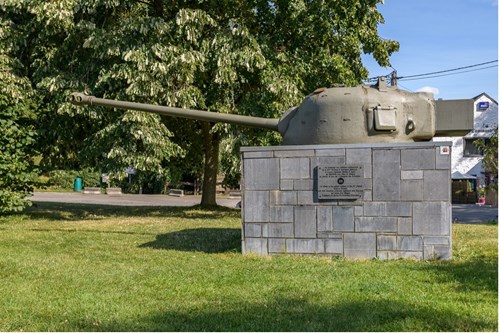
Turret of a British ‘Firefly’ Sherman tank dedicated to the 53rd (Welsh) Division and supporting armoured units (Rue de Haute) © WBT KF
In the first days of January 1945, it was from Hotton that several armoured and infantry units of XXX Corps launched the counter-offensive towards La Roche-en-Ardenne, with the aim of pushing back the Germans, cleaning out the west bank of the River Ourthe sector, and linking up with the Americans.
The Commonwealth War Graves Cemetery at the southern end of Hotton contains the remains of 666 soldiers and airmen, including an 18-year-old soldier of Belgian descent who fought in the uniform of the 53rd (Welsh) Division.
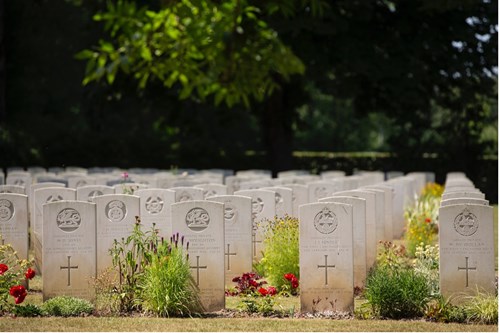
The Commonwealth War Graves Cemetery in Hotton, the last resting place of 666 soldiers and airmen. © WBT Chippy
La Roche-en-Ardenne

‘Achilles’ tank destroyer dedicated to the 1st Northamptonshire Yeomanry Regiment, which followed the 1st Black Watch into La Roche-en-Ardenne © WBT KF
On the freezing morning of 7 January 1945, the 51st (Highland) Division left their standby positions to the south of Liège and headed towards the front line between Marche and Hotton. Their mission was to relieve exhausted Welsh units and advance towards La Roche-en-Ardenne. After liberating the villages of Hodister, Warizy and Ronchampay on 11 January, the 1st Battalion Black Watch pushed on along the River Ourthe towards La Roche. Shortly before midday, preceded by a mine disposal team and armoured reconnaissance vehicles of the 2nd Derbyshire Yeomanry Regiment, the Scots entered the town devastated by American bombing. They were followed by supporting armoured vehicles of the 1st Northamptonshire Yeomanry Regiment.
When the town was liberated from its last German defenders and the main street cleared of debris, the other units of the Division moved off in turn, crossing La Roche and advancing towards the villages of Hives, Hubermont, Mièrchamps, Erneuville and Ortho, which they liberated, and linked up with the American troops.

Commemorative plaque near the bridge on the River Ourthe on the corner of Rue de la Gare and Rue de Cielle. © WBT KF
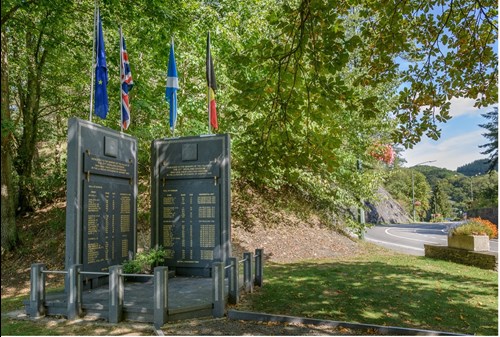
‘Roll of Honour’ Memorial to the 51st (Highland) Division, at the entrance of the town coming from Hotton © WBT P. Marée
The Battle of the Ardennes Museum
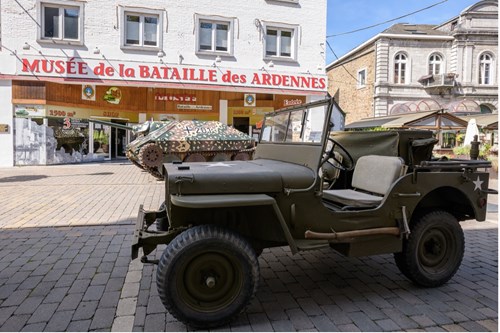
Museum entrance, Rue Chamont 5, in La Roche-en-Ardenne © WBT KF

Display with mannequins wearing original uniforms © WBT Chippy
With a section dedicated to the British, the museum spreads over three floors. The dioramas and showcases display more than 100 mannequins of American, British and German soldiers with their equipment and weapons, as well as uniforms donated by veterans who fought in the battle. Among them is the combat jacket of Lieutenant Colonel Cathcart, commander of the 7th Battalion Black Watch of the 51st (Highland) Division, who helped liberate La Roche.
The museum also displays personal objects found on the battlefield, light and heavy weapons, documents and photographs, and some military vehicles.
In the ‘Weapons Room’, some 90 rifles, pistols and revolvers are displayed, as well as one of the famous ‘Enigma’ cypher machines of Polish origin. www.batarden.be
The Commonwealth War Graves Commission has also published an excellent guide to the Battle of the Bulge. It highlights the role of 55,000 Commonwealth troops who fought in the Ardennes as well as a section devoted to the Battle of Bure: https://www.cwgc.org/our-work/blog/legacy-of-liberation-commonwealth-troops-at-the-battle-of-the-bulge/
Editing: Dennis Abbott